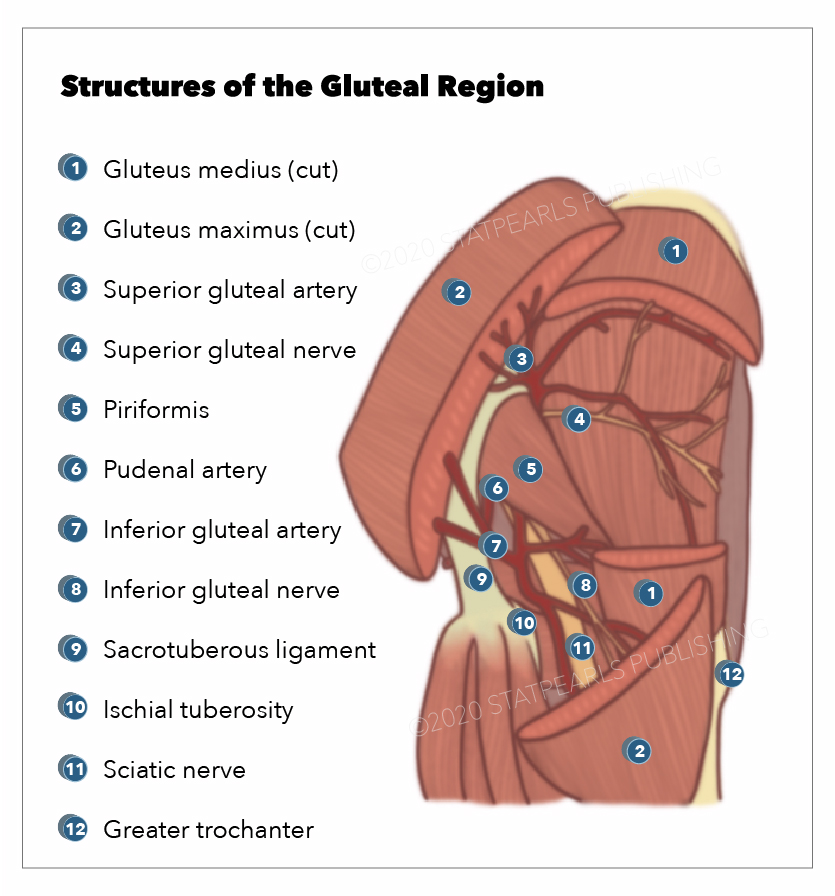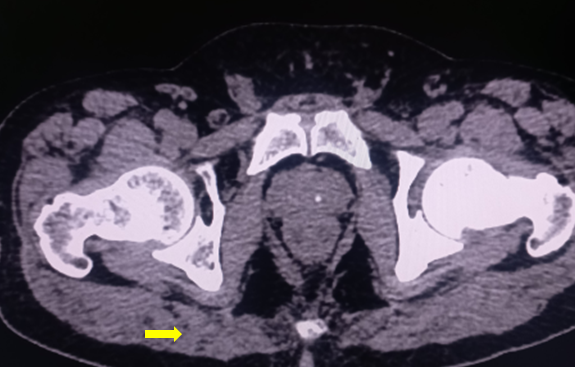[1]
Gallego-Izquierdo T, Vidal-Aragón G, Calderón-Corrales P, Acuña Á, Achalandabaso-Ochoa A, Aibar-Almazán A, Martínez-Amat A, Pecos-Martín D. Effects of a Gluteal Muscles Specific Exercise Program on the Vertical Jump. International journal of environmental research and public health. 2020 Jul 27:17(15):. doi: 10.3390/ijerph17155383. Epub 2020 Jul 27
[PubMed PMID: 32726899]
[2]
Lieberman DE, Raichlen DA, Pontzer H, Bramble DM, Cutright-Smith E. The human gluteus maximus and its role in running. The Journal of experimental biology. 2006 Jun:209(Pt 11):2143-55
[PubMed PMID: 16709916]
[3]
Bartlett JL, Sumner B, Ellis RG, Kram R. Activity and functions of the human gluteal muscles in walking, running, sprinting, and climbing. American journal of physical anthropology. 2014 Jan:153(1):124-31. doi: 10.1002/ajpa.22419. Epub 2013 Nov 12
[PubMed PMID: 24218079]
[4]
Onyemaechi N, Anyanwu E, Obikili E, Ekezie J. Anatomical basis for surgical approaches to the hip. Annals of medical and health sciences research. 2014 Jul:4(4):487-94. doi: 10.4103/2141-9248.139278. Epub
[PubMed PMID: 25221692]
[5]
Willard FH, Vleeming A, Schuenke MD, Danneels L, Schleip R. The thoracolumbar fascia: anatomy, function and clinical considerations. Journal of anatomy. 2012 Dec:221(6):507-36. doi: 10.1111/j.1469-7580.2012.01511.x. Epub 2012 May 27
[PubMed PMID: 22630613]
[6]
Barker PJ, Hapuarachchi KS, Ross JA, Sambaiew E, Ranger TA, Briggs CA. Anatomy and biomechanics of gluteus maximus and the thoracolumbar fascia at the sacroiliac joint. Clinical anatomy (New York, N.Y.). 2014 Mar:27(2):234-40. doi: 10.1002/ca.22233. Epub 2013 Aug 20
[PubMed PMID: 23959791]
[7]
Mu A, Peng P, Agur A. Landmark-Guided and Ultrasound-Guided Approaches for Trochanteric Bursa Injection: A Cadaveric Study. Anesthesia and analgesia. 2017 Mar:124(3):966-971. doi: 10.1213/ANE.0000000000001864. Epub
[PubMed PMID: 28079582]
[8]
Wisniewski SJ, Hurdle M, Erickson JM, Finnoff JT, Smith J. Ultrasound-guided ischial bursa injection: technique and positioning considerations. PM & R : the journal of injury, function, and rehabilitation. 2014 Jan:6(1):56-60. doi: 10.1016/j.pmrj.2013.08.603. Epub 2013 Aug 31
[PubMed PMID: 24001885]
[9]
Woodley SJ, Mercer SR, Nicholson HD. Morphology of the bursae associated with the greater trochanter of the femur. The Journal of bone and joint surgery. American volume. 2008 Feb:90(2):284-94. doi: 10.2106/JBJS.G.00257. Epub
[PubMed PMID: 18245587]
[10]
Kim SM, Yoo WG. Comparison of trunk and hip muscle activity during different degrees of lumbar and hip extension. Journal of physical therapy science. 2015 Sep:27(9):2717-8. doi: 10.1589/jpts.27.2717. Epub 2015 Sep 30
[PubMed PMID: 26504276]
[11]
Beazley D, Patel S, Davis B, Vinson S, Bolgla L. Trunk and hip muscle activation during yoga poses: Implications for physical therapy practice. Complementary therapies in clinical practice. 2017 Nov:29():130-135. doi: 10.1016/j.ctcp.2017.09.009. Epub 2017 Sep 14
[PubMed PMID: 29122250]
[12]
Tichý M, Grim M. Morphogenesis of the human gluteus maximus muscle arising from two muscle primordia. Anatomy and embryology. 1985:173(2):275-7
[PubMed PMID: 4083527]
[13]
Rocos B, Ward A. Gluteal compartment syndrome with sciatic nerve palsy caused by traumatic rupture of the inferior gluteal artery: a successful surgical treatment. BMJ case reports. 2017 Jan 25:2017():. doi: 10.1136/bcr-2016-216709. Epub 2017 Jan 25
[PubMed PMID: 28122800]
Level 3 (low-level) evidence
[14]
Saad PF, Saad KR, Armstrong DM, Soares BL, de Almeida PH, Razuk Filho Á. Inferior gluteal artery pseudoaneurysm related to intramuscular injection. International journal of surgery case reports. 2015:6C():29-32. doi: 10.1016/j.ijscr.2014.10.080. Epub 2014 Nov 27
[PubMed PMID: 25506847]
Level 3 (low-level) evidence
[15]
Apaydin N, Kendir S, Loukas M, Tubbs RS, Bozkurt M. Surgical anatomy of the superior gluteal nerve and landmarks for its localization during minimally invasive approaches to the hip. Clinical anatomy (New York, N.Y.). 2013 Jul:26(5):614-20. doi: 10.1002/ca.22057. Epub 2012 Feb 28
[PubMed PMID: 22374811]
[16]
Iwanaga J, Simonds E, Vetter M, Patel M, Oskouian RJ, Tubbs RS. The inferior gluteal nerve often has a cutaneous branch: A discovery with application to hip surgery and targeting gluteal pain syndromes. Clinical anatomy (New York, N.Y.). 2018 Sep:31(6):937-941. doi: 10.1002/ca.23232. Epub 2018 Oct 18
[PubMed PMID: 30335198]
[17]
Wang Y, Yang J, Yan Y, Zhang L, Guo C, Peng Z, Kong Q. Possible pathogenic mechanism of gluteal pain in lumbar disc hernia. BMC musculoskeletal disorders. 2018 Jul 11:19(1):214. doi: 10.1186/s12891-018-2147-y. Epub 2018 Jul 11
[PubMed PMID: 29996837]
[18]
Duda GN, Brand D, Freitag S, Lierse W, Schneider E. Variability of femoral muscle attachments. Journal of biomechanics. 1996 Sep:29(9):1185-90
[PubMed PMID: 8872275]
[19]
Sugisaki N, Kobayashi K, Tsuchie H, Kanehisa H. Associations Between Individual Lower-Limb Muscle Volumes and 100-m Sprint Time in Male Sprinters. International journal of sports physiology and performance. 2018 Feb 1:13(2):214-219. doi: 10.1123/ijspp.2016-0703. Epub 2018 Feb 13
[PubMed PMID: 28605265]
[20]
Navandar A, Veiga S, Torres G, Chorro D, Navarro E. A previous hamstring injury affects kicking mechanics in soccer players. The Journal of sports medicine and physical fitness. 2018 Dec:58(12):1815-1822. doi: 10.23736/S0022-4707.18.07852-0. Epub 2018 Jan 10
[PubMed PMID: 29327823]
[21]
Orozco-Chavez I, Mendez-Rebolledo G. Effect of squatting velocity on hip muscle latency in women with patellofemoral pain syndrome. Journal of physical therapy science. 2018 Mar:30(3):381-386. doi: 10.1589/jpts.30.381. Epub 2018 Mar 2
[PubMed PMID: 29581655]
[22]
Hanly RJ, Sokolowski S, Timperley AJ. The SPAIRE technique allows sparing of the piriformis and obturator internus in a modified posterior approach to the hip. Hip international : the journal of clinical and experimental research on hip pathology and therapy. 2017 Mar 31:27(2):205-209. doi: 10.5301/hipint.5000490. Epub 2017 Feb 8
[PubMed PMID: 28218374]
[23]
Han JH, Wang HF, Chen FH, Chen G. [Treatment of Pipkin I and II hip fractures by anterolateral hip approach]. Zhongguo gu shang = China journal of orthopaedics and traumatology. 2018 Sep 25:31(9):858-862. doi: 10.3969/j.issn.1003-0034.2018.09.015. Epub
[PubMed PMID: 30332881]
[24]
Janjua MB, Ozturk A, Piazza M, Passias P, Arlet V, Welch WC. Technical nuances of percutaneous sacroiliac joint fixation: A cadaveric study. Journal of clinical neuroscience : official journal of the Neurosurgical Society of Australasia. 2019 Mar:61():315-321. doi: 10.1016/j.jocn.2018.10.130. Epub 2018 Nov 10
[PubMed PMID: 30424968]
[25]
Saeed A, Narayan N, Troisi L. A propeller SGAP flap raised from a previous gluteus maximus myocutaneous flap to reconstruct a recurrent type IV sacral pressure ulcer. Microsurgery. 2018 Nov:38(8):924-925. doi: 10.1002/micr.30380. Epub 2018 Nov 21
[PubMed PMID: 30462854]
[26]
Chou CY, Sun YS, Shih YJ, Tzeng YS, Chang SC, Dai NT, Lin CT. A Descriptive, Retrospective Study of Using an Oblique Downward-design Gluteus Maximus Myocutaneous Flap for Reconstruction of Ischial Pressure Ulcers. Ostomy/wound management. 2018 Mar:64(3):40-44
[PubMed PMID: 29584611]
Level 2 (mid-level) evidence
[27]
Ricciardi BF, Henderson PW, McLawhorn AS, Westrich GH, Bostrom MP, Gayle LB. Gluteus Maximus Advancement Flap Procedure for Reconstruction of Posterior Soft Tissue Deficiency in Revision Total Hip Arthroplasty. Orthopedics. 2017 May 1:40(3):e495-e500. doi: 10.3928/01477447-20170308-06. Epub 2017 Mar 15
[PubMed PMID: 28295126]
[28]
Jang SA, Cho YH, Byun YS, Gu TH. Abductor Reconstruction with Gluteus Maximus Transfer in Primary Abductor Deficiency during Total Hip Arthroplasty. Hip & pelvis. 2016 Sep:28(3):178-181
[PubMed PMID: 27777922]
[29]
Brault N, Qassemyar Q, Bouthors C, Lambert B, Atlan M, Missenard G. [A giant sacral chordoma resection and reconstruction with a gluteal perforator flap, a case report and literature review]. Annales de chirurgie plastique et esthetique. 2019 Jun:64(3):271-277. doi: 10.1016/j.anplas.2018.10.004. Epub 2018 Dec 1
[PubMed PMID: 30509683]
Level 3 (low-level) evidence
[30]
Seijas R, Marín M, Rivera E, Alentorn-Geli E, Barastegui D, Álvarez-Díaz P, Cugat R. Gluteus maximus contraction velocity assessed by tensiomyography improves following arthroscopic treatment of femoroacetabular impingement. Knee surgery, sports traumatology, arthroscopy : official journal of the ESSKA. 2018 Mar:26(3):976-982. doi: 10.1007/s00167-017-4572-0. Epub 2017 May 13
[PubMed PMID: 28501988]
[31]
Ling ZX, Kumar VP. The course of the inferior gluteal nerve in the posterior approach to the hip. The Journal of bone and joint surgery. British volume. 2006 Dec:88(12):1580-3
[PubMed PMID: 17159167]
[32]
Apaydin N, Bozkurt M, Loukas M, Tubbs RS, Esmer AF. The course of the inferior gluteal nerve and surgical landmarks for its localization during posterior approaches to hip. Surgical and radiologic anatomy : SRA. 2009 Jul:31(6):415-8. doi: 10.1007/s00276-008-0459-6. Epub 2009 Feb 4
[PubMed PMID: 19190851]
[33]
DeJong AF, Mangum LC, Resch JE, Saliba SA. Detection of Gluteal Changes Using Ultrasound Imaging During Phases of Gait in Individuals With Medial Knee Displacement. Journal of sport rehabilitation. 2019 Jul 1:28(5):494-504. doi: 10.1123/jsr.2017-0336. Epub 2018 Dec 17
[PubMed PMID: 29543116]


